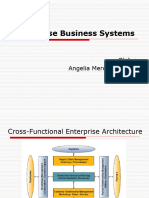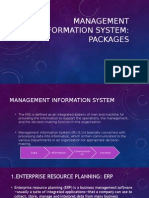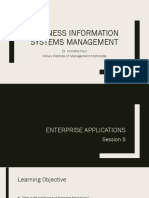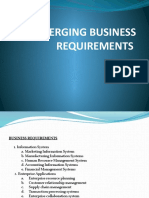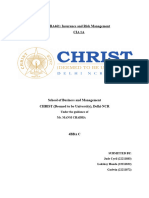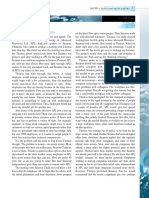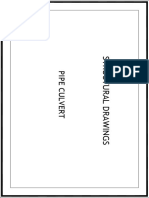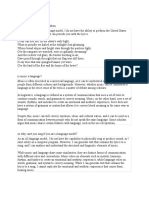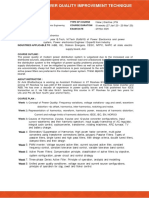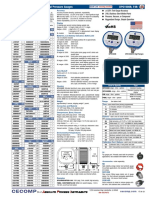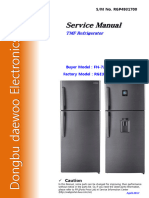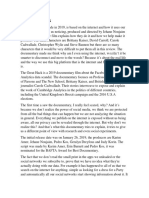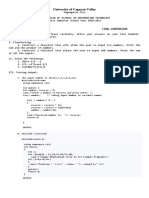Information Systems for
Business
Unit-3
�Topics to be covered in [4 Sessions]
• Business Process Integration
• Enterprise Business Applications
• Overview of ERP, SCM, CRM
• International Information Systems, DSS
• Analytics and Business Intelligence
• Knowledge Management System
• OLTP, OLAP, RPA, OCR
�Business Process Integration
• Business Process Integration (BPI) refers to the strategic alignment
and coordination of various processes, systems, and functions within
an organization to enhance efficiency, streamline operations, and
improve overall business performance.
• It involves the seamless flow of information, tasks, and activities
across different departments, systems, and technologies to create a
unified and cohesive environment.
�Business Process Integration
• The primary goal of Business Process Integration is to eliminate silos
and bottlenecks that can hinder the smooth functioning of an
organization.
• By integrating processes, organizations can achieve a range of
benefits:
• Efficiency and Productivity
• Data Accuracy and Consistency
• Visibility and Transparency
• Customer Satisfaction
• Cost Savings
• Innovation
�Business Process Integration
• There are different levels of Business Process Integration:
• Vertical Integration
• Horizontal Integration
• Enterprise Integration
• Supply Chain Integration
• Technology Integration
• To implement Business Process Integration successfully, organizations may
need to invest in technologies such as integration platforms, middleware,
APIs (Application Programming Interfaces), and standardized data formats.
• Additionally, a clear understanding of existing processes, effective change
management, and collaboration among different teams are essential for a
successful BPI initiative.
�����Enterprise Business
Applications
��Overview of ERP,
SCM, CRM
�Enterprise Resource Planning (ERP)
• Enterprise resource planning (ERP) refers to a type of software that
organizations use to manage day-to-day business activities such as
accounting, procurement, project management, risk management
and compliance, and supply chain operations.
• ERP is an application that automates business processes and provides
insights and internal controls, drawing on a central database that
collects inputs from departments including accounting,
manufacturing, supply chain management, sales, marketing, and
human resources (HR).
��Enterprise
Resource
Planning
(ERP)
��Supply Chain Management (SCM)
�Supply Chain Management (SCM)
• It is the process of overseeing and optimizing the flow of goods,
services, information, and finances across the entire network of
suppliers, manufacturers, distributors, retailers, and customers.
• The primary goal of SCM is to ensure that products are produced and
delivered to the right place, at the right time, and in the most
efficient and cost-effective manner.
• It comprises of a chain from SUPPLIER CUSTOMER
���SCM Components
• Suppliers: These are the sources from which a company procures the raw
materials, components, or finished goods that are needed for production.
• Manufacturing/Production: This is where the raw materials and components are
transformed into finished goods through various processes.
• Distribution/Warehousing: Once the products are manufactured, they are stored
in warehouses and distribution centers until they are ready to be shipped to
customers.
• Logistics/Transportation: This involves the transportation of products from the
manufacturing or distribution centers to the retailers or directly to end
consumers.
• Retailers: These are the entities that sell products directly to consumers through
physical stores or online platforms.
• Customers: These are the end-users who purchase and use the products.
�Key SCM Concepts
• Demand Forecasting: Predicting customer demand to ensure that the right
amount of products are produced or stocked.
• Inventory Management: Maintaining the optimal level of inventory to prevent
shortages or excess stock, minimizing carrying costs.
• Order Fulfillment: Efficiently processing and delivering customer orders to meet
their expectations.
• Supplier Relationship Management: Building strong relationships with suppliers to
ensure a steady and reliable supply of materials.
• Information Flow: Sharing timely and accurate information across the supply
chain to enable better decision-making.
• Risk Management: Identifying and mitigating potential disruptions in the supply
chain, such as natural disasters or geopolitical events.
• Sustainability and Ethics: Considering environmental and ethical factors in supply
chain decisions to promote responsible business practices.
• Remember, real-world supply chains can be much more complex and involve
multiple stages, intermediaries, and technologies to optimize the entire process.
���SCM Softwares
• SAP Supply Chain Management • Microsoft Dynamics 365 Supply
• Oracle SCM Cloud Chain Management
• IBM Sterling Supply Chain Suite • Infor SCM
• Kinaxis RapidResponse • SAP Ariba
• JDA (Blue Yonder) Supply Chain • E2open
Management • PLEX
• Logility • Anaplan
• LLamasoft Supply Chain Guru
• Manhattan Associates • Details in Slide Notes Below
�Customer Relationship Management
(CRM)
�Customer Relationship Management (CRM)
• It refers to a set of strategies, processes, and technologies that
businesses use to manage and nurture their relationships with
existing and potential customers.
• The primary goal of CRM is to enhance customer satisfaction, and
retention, and ultimately, drive business growth by understanding
customer needs and delivering personalized experiences.
����Key aspects of CRM
• Customer Data Centralization: CRM systems gather and store customer information such
as contact details, purchase history, preferences, and interactions. This centralized
database helps businesses have a comprehensive view of each customer.
• Sales Automation: CRM tools streamline sales processes by automating tasks like lead
management, opportunity tracking, and sales forecasting. This enables sales teams to
focus on building relationships and closing deals.
• Marketing Automation: CRM systems facilitate targeted marketing campaigns by
segmenting customers based on their preferences and behaviors. This helps businesses
deliver relevant messages and offers to different customer groups.
• Customer Service and Support: CRM systems help manage customer inquiries, complaints,
and requests. Support teams can access customer information quickly, leading to faster
and more personalized responses.
• Analytics and Reporting: CRM software provides insights into customer behavior, buying
patterns, and overall satisfaction. This data helps businesses make informed decisions to
improve products, services, and customer interactions.
�Key aspects of CRM
• Contact Management: CRM platforms allow businesses to organize and maintain
a comprehensive contact list, ensuring accurate and up-to-date customer
information.
• Lead Management: CRM tools help track and manage leads throughout the sales
pipeline, from initial contact to conversion.
• Workflow Automation: Many CRM systems enable automation of routine tasks
and workflows, reducing manual work and increasing efficiency.
• Integration: CRM systems can integrate with other business tools such as email
marketing platforms, e-commerce platforms, and customer support software,
creating a unified view of customer interactions.
• Mobile Accessibility: Modern CRM systems often have mobile apps or responsive
interfaces, allowing sales and support teams to access customer information and
perform tasks on the go.
�CRM
• Overall, CRM aims to create a customer-centric approach to business,
where interactions with customers are tailored, timely, and valuable.
• By effectively managing customer relationships,
• businesses can increase customer loyalty,
• improve customer retention rates,
• identify opportunities for cross-selling or upselling, and
• ultimately drive revenue growth.
��CRM Softwares
• Popular CRM software options include
• Salesforce,
• Microsoft Dynamics 365,
• HubSpot CRM,
• Zoho CRM, and many others.
• The choice of CRM system depends on the specific needs of your
business, the size of your organization, and the features you require
to effectively manage customer relationships.
�International
Information Systems,
DSS
�International Information Systems (IIS)
• It refers to the interconnected and global network of
• information systems,
• technologies, and
• processes
• It enables the exchange, storage, processing, and management of
information across international borders.
• These systems play a crucial role in facilitating communication,
collaboration, and decision-making on a global scale.
• Key components of International Information Systems include:
��IIS
• Key components of International Information Systems include:
• Global Communication Networks
• Cross-Border Data Exchange
• Multinational Corporations (MNCs)
• E-Government and Diplomacy
• Global Supply Chain Management
• Cultural and Language Considerations
• Cybersecurity and Data Privacy
• International Collaboration and Research
• International Trade and E-Commerce
• Crisis Management and Disaster Response
�IIS - Summary
• International Information Systems form the backbone of
• modern global interactions,
• enabling communication,
• trade,
• diplomacy,
• research, and
• various other activities across international boundaries.
• As technology continues to evolve, the role of IIS in shaping our
interconnected world will likely become even more significant.
�Business Analytics and
Business Intelligence
�Business Analytics and Business Intelligence
�Business Analytics and Business Intelligence
��Knowledge Management
System
�Knowledge Management System
• A Knowledge Management System (KMS) is a framework or set of
processes that helps organizations capture, store, organize, and
disseminate knowledge within their workforce.
• A KMS is a structured approach to capturing, organizing, and sharing
an organization's collective knowledge to enhance decision-making,
problem-solving, and innovation.
• Types of Knowledge: KMS deals with explicit knowledge (documented
information) and tacit knowledge (knowledge residing in people's
minds).
�Knowledge Management System
• Knowledge Capture: KMS allows for the systematic capture of
knowledge through various means, such as documentation,
databases, interviews, surveys, and knowledge harvesting.
• Example: A company's engineers document best practices for
troubleshooting common technical issues and store them in a
knowledge base.
�Knowledge Management System
• Knowledge Organization: KMS categorizes and organizes knowledge
for easy retrieval and use. This can involve taxonomies, tagging, and
metadata.
• Example: A law firm categorizes legal case studies based on practice
areas, jurisdictions, and client industries for easy reference.
• Knowledge Sharing: KMS facilitates knowledge sharing among
employees through tools like intranets, forums, wikis, and
collaborative platforms.
• Example: An online forum where IT professionals share solutions to
software problems they've encountered.
�Knowledge Management System
• Knowledge Retrieval: KMS should provide quick and efficient retrieval
of knowledge when needed, often through search functionalities.
• Example: An employee searches for "customer onboarding process"
and finds a step-by-step guide.
• Continuous Updating: KMS requires regular updates to keep
knowledge current and relevant. Knowledge stewards or content
managers often oversee this.
• Example: An e-commerce company updates its product catalog with
new items and removes discontinued ones.
�Knowledge Management System
• Expertise Location: KMS helps identify subject matter experts within
an organization, making it easier to connect employees with the right
expertise.
• Example: An employee searches for an expert in blockchain
technology and finds a colleague who specializes in it.
• Knowledge Transfer: KMS aids in transferring knowledge from
departing employees to new hires or colleagues to ensure the
continuity of critical knowledge.
• Example: A retiring project manager conducts knowledge transfer
sessions with their successor.
�Knowledge Management System
• Performance Improvement: KMS can lead to better decision-making,
increased productivity, reduced errors, and improved innovation by
providing access to relevant knowledge.
• Example: A manufacturing company uses historical data and best
practices stored in the KMS to optimize production processes,
reducing defects.
• Security and Privacy: KMS should incorporate security measures to
protect sensitive information and ensure privacy compliance.
• Example: Healthcare organizations must implement strict access
controls in their KMS to safeguard patient records.
�Knowledge Management System
• Measuring Success: Organizations should establish key performance
indicators (KPIs) to evaluate the effectiveness of their KMS, such as
knowledge usage, user satisfaction, and impact on decision-making.
• Example: An organization tracks the number of times knowledge
articles are accessed and user feedback to assess the KMS's success.
• Integration with other Systems: KMS often integrates with other
business systems like CRM, ERP, and project management tools to
provide seamless access to knowledge.
• Example: A customer support team can access customer information
stored in the CRM system directly from the KMS.
�Knowledge Management System
• Scalability and Flexibility: KMS should be able to adapt to the evolving
needs of the organization and scale as knowledge grows.
• Example: A startup's KMS initially focuses on basic product
documentation but expands to include customer support materials as
the company grows.
• Cultural Change: Implementing a KMS may require a cultural shift
towards knowledge sharing and collaboration within the
organization.
• Example: A traditionally hierarchical organization encourages
employees to share knowledge openly and rewards those who
contribute to the KMS.
�Knowledge Management System
• Knowledge Management System is a strategic tool for organizations
to harness and leverage their knowledge assets for better
decision-making, increased innovation, and improved performance.
• It encompasses various processes and technologies to facilitate
knowledge capture, organization, sharing, and utilization.
• Successful KMS implementation can lead to significant benefits for
organizations across various industries.
�Online Transaction
Processing
�Online Transaction Processing
• Online analytical processing (OLAP) and online transaction processing
(OLTP) are two different data processing systems designed for
different purposes.
• OLAP is optimized for complex data analysis and reporting, while
• OLTP is optimized for transactional processing and real-time updates.
�Online Analytical
Processing
�Online Analytical Processing
��Robotic Process
Automation
�� Robotic
Process
Automation
��Optical Character Recognition
�Optical
Character
Recognition
�Optical
Character
Recognition






